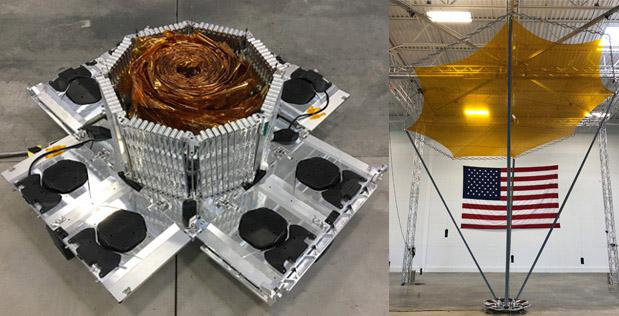R3D2 Going to Space
The Defense Advanced Research Projects Agency's (DARPA’s) development of a new type of membrane reflect-array antenna as part of its Radio Frequency Risk Reduction Deployment Demonstration (R3D2) program is ready to be space qualified, the agency reports, and anticipates that R3D2 will be launched in late February.
The agency stated that the antenna could enable multiple missions that usually depend on large satellites. R3D2 was produced with a “tissue-thin Kapton membrane” or a polyamide film, which allows the antenna to compact during launch and then deploy to a full size of 2.25 meters in diameter once it reaches low-Earth orbit, according to DARPA.
“R3D2 will monitor antenna deployment dynamics, survivability and radio frequency (RF) characteristics of a membrane antenna in low-Earth orbit,” the agency reported. “A successful demonstration also will help prove out a smaller, faster-to-launch and lower cost capability, allowing the Department of Defense, as well as other users, to make the most of the new commercial market for small, inexpensive launch vehicles.”
Several industry partners contributed to the development and production of R3D2: Northrop Grumman is the prime contractor and integrated the 150 kg satellite; MMA Design designed and built the antenna; Trident Systems designed and built the unit’s software-defined radio; and Blue Canyon Technologies provided the spacecraft bus.
The R3D2 effort could help validate other emerging concepts, including a resilient sensor and data transport layer in low Earth orbit, which could revolutionize global communications with the beginnings of a space-based Internet, explained Fred Kennedy, director of DARPA’s Tactical Technology Office.
“The Department of Defense has prioritized rapid acquisition of small satellite and launch capabilities,” Kennedy said. “By relying on commercial acquisition practices, DARPA streamlined the R3D2 mission from conception through launch services acquisition."
Los Angeles-based Rocket Lab USA announced it would launch R3D2 on the company’s Electron rocket from its Launch Complex 1 on the Māhia Peninsula of New Zealand.
“Rapid acquisition of small satellite launch capabilities is increasingly important to U.S. government organizations like DARPA. The ability to rapidly space-qualify new technology and deploy space-based assets with confidence on short notice is a service that didn’t exist for dedicated small satellites until now,” said Peter Beck, Rocket Lab’s founder and CEO. “We’re honored to provide Electron’s agile and flexible launch service to DARPA and we look forward to delivering the innovative R3D2 payload to orbit.”





Comments